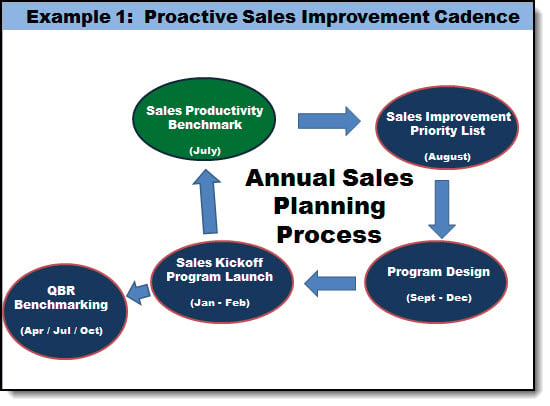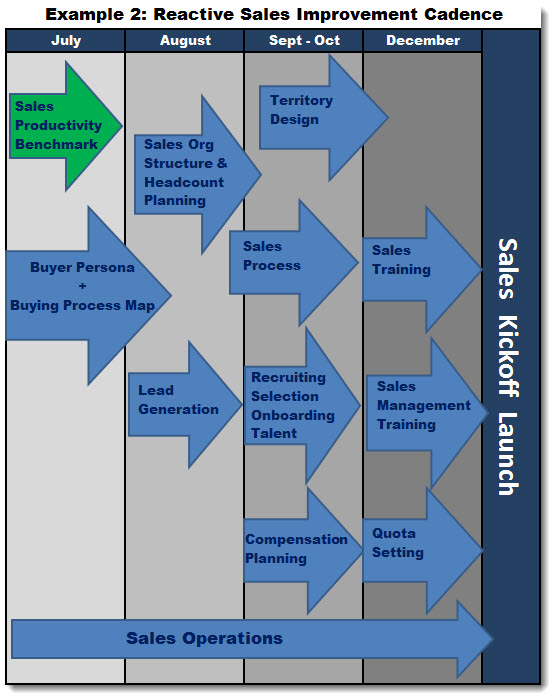How to Plan Your Sales Year
How to Plan Your Sales Year:
“When do I get it?”
from Sales Force Effectiveness Blog
I am being asked this question a lot. I work with CEOs, and their sales and marketing leaders. They are an impatient group. “It” refers to the deliverables associated with the sales effectiveness project. Things like head count plans, compensation and quotas, methodologies, etc.
I typically get asked this when a customer buys our Sales Productivity Benchmark. There is something about this offering. When a customer sees it they say, “I want one.”
See for yourself what all the fuss is about. Get a copy of our Sales Productivity Benchmark here. Learn how to determine if you are better than the typical sales team.
My response is often “at what point are you in your sales year?”
I usually hear something like “Q2”, or a month, such as “October.” This is a response from a leader who treats sales improvement programs as an event. This is also an incorrect response.
Sales effectiveness is not a one-time event. It is an ongoing, cyclical business improvement process.
I recommend turning one-time sales effectiveness programs into cyclical business processes. There are two ways to do so:
- Proactively
- Reactively
Reactive programs are initiated by external events. For example, a chronic underperformance from the sales team. Or, an attack by a competitor. They are often very large with many improvement initiatives, performed in chaos.
The best sales organizations institutionalize proactive sales effectiveness programs. This gets accomplished by turning sales effectiveness programs into a cyclical business process.
Here is an example of a Proactive Cyclical SFE Program Calendar:
 This approach allows for sales improvements year after year. It is standard operating procedure.
This approach allows for sales improvements year after year. It is standard operating procedure.In contrast, here is an example of a Reactive Cyclical SFE Program Calendar:

You can see many sales improvements happening at once, in a somewhat chaotic way. External events have a way of forcing us to do things we don’t want to do. Sales effectiveness, done this way, is not fun. This can be avoided.
In this example, “Top of Funnel” initiatives include items such as Buying Process Maps. Change in any top of funnel item will necessitate change to many of the mid-to-bottom funnel items. And so on down the line it goes.
Three things to note from both approaches to the sales calendar:
- Both begin with a sales benchmark. It is a poor decision to change anything without a baseline.
- Both usually begin in July and end in December.
- Both extend benchmarking into post-launch QBR (quarterly business review) benchmarking.
The goal is to get to a proactive calendar. This way the question of “when do I get it” can be put into proper context. For example, working on comp plans in May might not make sense. But, if you are on a calendar fiscal, it does make sense in October. Companies who institutionalize SFE into a cyclical business process force their competitors to be reactive. By forcing your competitors into chaos, you will beat them.
A reactive sales calendar cannot be avoided at times. For example, there are many trigger events that dictate it. A global recession can force you to be reactive. A loss of a major customer might cause a reaction as well. When this happens, it is perfectly acceptable to switch from proactive to reactive.
3 key take aways:
- Start all calendars with a benchmark. Here is an example of our Sales Productivity Benchmark.
- Convert your sales effectiveness program into a cyclical business process. One-time events are not very helpful.
- Get your team together before July. Review with them the two examples in this article. Draw your version on the white board.
Author: Greg Alexander
Follow @GregAlexander
Follow @MakingTheNumber
If you enjoyed this post, get free updates by subscribing by Email or RSS.



No comments:
Post a Comment